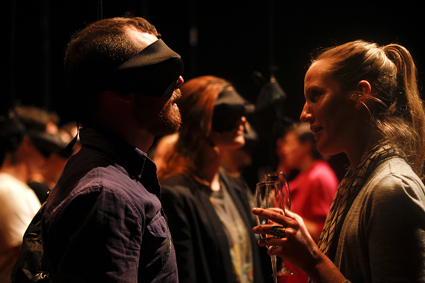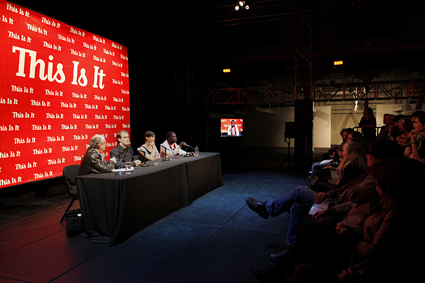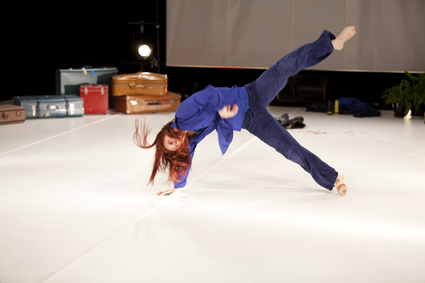 |
Thrashing Without Looking, Aphids photo Ponch Hawkes |
Curation, in Anton Vidokle’s much-quoted words (e-flux Journal 16, May, 2010) now routinely oversteps the line, becoming a “reinforcement of authorial claims that render artists and artworks merely actors and props for illustrating curatorial concepts. Movement in such a direction runs the serious risk of diminishing the space of art by undermining the agency of its producers: artists.” However, as Alison Croggon has put it elsewhere, without critical reflection on the art of the times, without drawing connections, instead of a culture we will merely have ‘a lot of art.’
While offering much to enjoy this year, Melbourne’s Arts House has so far presented us largely with a lot of art. While I concede that it might understand its role as presentational rather than culture-shaping, as serving the artist rather than imposing a zeitgeist, Arts House is nonetheless the premiere venue for live art in Victoria. It makes programming decisions that shape how this city understands an artform; its lack of explanation does not diminish its curatorial power—it merely renders it opaque. Finally, I am unsure whether artists benefit from this silence at all if, as this year, the programming presents works of clashing sensibilities; works that, without proper juxtaposition, appear to negate each other’s propositions, ideas and statements.
By way of example: members of Sydney-based Team MESS introduced two intriguing participatory works, both sitting broadly within the British-inflected tradition of live art in which the unpredictable, artless liveness of the performance event is its chief intriguing ingredient, and art-ness obtained almost exclusively from the framing of the encounter. The first, This Is It, is set up as a press conference for a non-existent film that—judging by the promotional material we are offered—merrily merges an infinitude of clichés of Australian cinema: a moody drama about a childless couple, haunted by suburban malaise and a mysterious dark-skinned stalker. The actors are terrific as diplomatic mouthpieces for the film: some with underlying anxieties (Malcolm Whittaker’s hands almost imperceptibly shaking throughout the evening), some unflappable in their pretty muteness (Kate Randall, perhaps a dumb starlet, but perhaps simply settled into her role as conference eye-candy); and finally Frank Mainoo, explaining that his character is simply “darkness,” “the Other” and “really a plot device more than a character.”
 |
This Is It, Team MESS photo Ponch Hawkes |
The second work was Malcolm Whittaker’s A Lover’s Discourse, a love-letter-writing project for perfect strangers. As any performative dimension is completely absent from this collaborative effort, it presented itself through participants’ personal accounts, followed by attempts to find their correspondents live on Omegle (a roulette-like, random pairing chat room). While the event soon became tedious, as one’s recommended daily intake of irony was surpassed, it ended with a queue to sign up for further letter writing.
Both these works create only tenuous artistic frames around a collaborative exchange between participants who are only vaguely aware of the project’s agenda and in no way prevented from hijacking it. Indeed, the wide margin allowed for creative play is the biggest strength of both projects and much of the enjoyment seems to derive from actively testing the elasticity of the artful boundaries.
By contrast, Thrashing Without Looking, a project bringing together a number of prominent Melbourne-based live artists, divided the audience into two groups: one that assembled a karaoke video from a cryptic menu, and the other, strapped into video goggles (thus watching the event from the camera’s point of view), obediently executed their selection. Participation is the wrong word entirely to describe the audience’s role in this work. It is more accurate to think of us as theatre fodder, disoriented bodies reacting to a confusion of sensory inputs, or choosing through such a short list of options that a randomising script could have easily done the same job. However, the main interest of Thrashing Without Looking is in something else entirely: the old-fashioned blurring of mediated and live experience and the emotional and sensory vulnerability it provokes. (See John Bailey's review.)
Post’s Who’s the Best? sails through similar waters, although the blurring here is, as usual, between the performers’ real and their performed selves. The technology is not only reduced to the bare bones of theatre (curtains and lights), but even those are wonky: the contest to decide which of the three members is the best is constantly undermined by the stage going about its own business, structuring the banter into a Shakespearean dramatic curve largely on light and sound alone (not dissimilar to Nature Theater of Oklahoma’s NO DICE). (See review in RT104)
 |
I left My Shoes on the Warm Concrete and Stood in the Rain, Gabrielle Nankivell photo Ponch Hawkes |
The same could be said for Gabrielle Nankivell’s poetic I Left My Shoes on Warm Concrete and Stood in the Rain. It is a dance work weighed down by dense narration closely collaborating with sound and light (Luke Smiles and Benjamin Cisterne) to create a syncretic image of anxieties and fears plaguing a young woman. While technically impeccable and brilliantly performed, formally it is no more than an introspective dance poem, and it is unclear what prompted its inclusion in this ostensibly live art program.
Finally, what to make of the inclusion of Joan Baixas’ Pregnant Earth? An astonishing work, which incorporates live painting, puppetry and spoken narrative, from one of Spain’s great artists, it was both timeless and not of the moment. It revealed a depth of craft and a relatively independent set of concerns that needed to be somehow brought back into relation with the more fumbling, but fresher, set of local performances we had witnessed immediately prior. Without such a context, Baixas’ delicate and violent narrative, which moved from the burnt National Library of Sarajevo to a puppet that did not like to perform, was both weighty and stupefying.
We have come to expect such radical decontextualisation from mainstream festivals, which in Australia function exclusively as showcases and, indeed, Pregnant Earth would have made perfect sense had it been programmed in the Melbourne International Arts Festival. And yet, if even food and film festivals shape their programs with some subheadings and introductions, how is it possible that suggesting the same to an arts festival has become a hallmark of art sabotage?
Arts House: This Is It, created by Team MESS, performers Frank Mainoo, Natalie Randall, Malcolm Whittaker, Meat Market, Aug 5; A Lover’s Discourse, devised by Malcolm Whittaker, Meat Market, Aug 12; Thrashing Without Looking, creators Martyn Coutts, Elizabeth Dunn, Tristan Meecham, Lara Thoms, Willoh S Weiland, North Melbourne Town Hall, Aug 3-7; Who’s the Best?, devised and performed by post: Zoe Coombs Marr, Mish Grigor, Natalie Rose with Eden Falk, Meat Market, Aug 3-6; Of the Causes of Wonderful Things, writer, deviser, performer Talya Rubin, co-deviser, director Nick James, Meat Market, Aug 11-13; I Left My Shoes on Warm Concrete and Stood in the Rain, text, physical content & performance Gabrielle Nankivell, sound Motion Laboratories - Luke Smiles, design Benjamin Cisterne, North Melbourne Town Hall, Aug 11-13; Pregnant Earth, devisor, performer Joan Baixas, Arts House Meat Market, Melbourne Aug 16-17
RealTime issue #105 Oct-Nov 2011 pg. 36
© Jana Perkovic; for permission to reproduce apply to [email protected]








 back
back